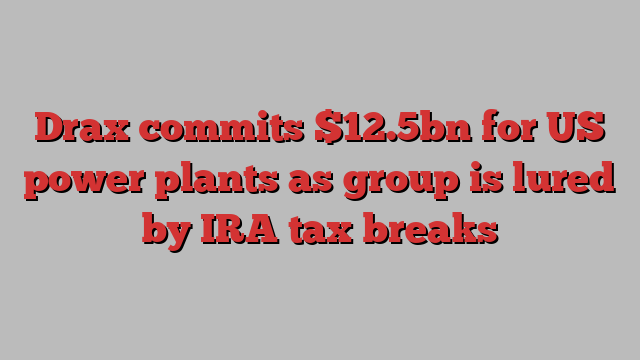
Unlock the Editor’s Digest for free
Roula Khalaf, Editor of the FT, selects her favourite stories in this weekly newsletter.
UK electricity group Drax is committing up to $12.5bn in the US over the next decade to build power plants to take advantage of the country’s lucrative subsidies and expectations of surging energy demand.
Drax, which operates the UK’s largest power station in the north of England, will build the plants under its Houston-based subsidiary Elimini, which launched on Tuesday.
It could help the US economy as it faces an energy supply crunch with power needs set to soar as data centres proliferate to cope with the demands of artificial intelligence.
The plants will generate electricity by burning biomass such as wood and then capture the emissions produced. The technique is known as bioenergy with carbon capture and storage or BECCS.
The process is considered “carbon negative” in some accounting metrics because in addition to capturing emissions, the biomass burnt has also absorbed carbon in its lifetime.
“We’re exporting British capability now,” Will Gardiner, Drax chief executive, told the Financial Times. “The UK is an interesting and exciting market, but we need to do more than that.”
Drax is planning to install carbon capture equipment at its power station in Yorkshire, dependent on government support.
It is evaluating more than 20 potential sites in North America under Elimini, with an aim to build up to five plants in the US over the next 10 years with a combined capacity of about 750MW of electricity — enough to provide power for more than 600,000 homes.
The company estimates that each US plant will remove about 1.5mn tonnes of carbon dioxide per year and be eligible for more than $100mn in tax breaks annually from President Joe Biden’s Inflation Reduction Act.
However, some analysts say the company’s plans could prove challenging as carbon removal technologies remain expensive and have yet to be produced at scale.
The company’s US drive comes as European investors pump billions into the US market to take advantage of the IRA’s clean energy subsidies.
The US is also facing new power demands from data centres for AI, electrification, and industrial onshoring. Consultancy ICF estimates that electricity demand could increase by an average of 9 per cent by 2028, posing a risk to reliability and affordability.
Laurie Fitzmaurice, president of Elimini, said that the US will require low carbon electricity sources such as BECCS that are available around the clock to avoid the intermittency problems of wind and solar.
“There’s a tremendous amount of load growth happening,” Fitzmaurice said. “We need a decarbonised energy system that has that base of dispatchable renewable energy.”
Elimini also plans to sell carbon dioxide removal credits from its global portfolio of projects with an announcement on Tuesday of six offtake deals, agreements to buy credits used to offset emissions, totalling 28,000 tonnes. While the company declined to offer a price, previous contracts averaged $300 per tonne.
Brenna Casey, a carbon capture analyst at BloombergNEF, called BECCS a “compelling option” for carbon removal given its dual revenue streams.
“You can sell power to the market and make a profit, or you can sell credits,” Casey said, cautioning that steep selling prices and limited sustainable supplies of biomass remain constraints to the sector’s ability to scale.
Drax’s bet on BECCS has come under scrutiny from environmentalists, who raise concerns over the sustainability of burning organic matter such as forests.
The International Energy Agency estimates that carbon dioxide removal from BECCS plants will need to reach 185mn tonnes per year by 2030 to be on track for net zero by mid-century, up from the 60mn tonnes committed today.
Additional reporting by Rachel Millard in London